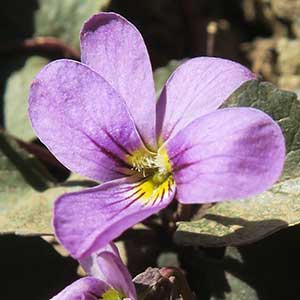Viola flettii
Viola blanda
Flett's violet, Olympic violet, rock violet
sweet white violet, violette agréable
1–3, ascending to erect, mostly glabrous, on caudex from fleshy rhizome.
basal and cauline;
basal: 1–3;
stipules linear-lanceolate, margins entire or with glandular processes, apex acuminate;
petiole 1.5–9.7 cm, mostly glabrous;
blade purple-tinted and –veined, broadly reniform to ovate, 0.9–2.4 × 1.2–4 cm, base cordate, margins finely crenate-serrate, eciliate, apex acute to obtuse, surfaces glabrous or sparsely pubescent along veins adaxially;
cauline similar to basal except: stipules ovate to lanceolate, margins entire or shallowly laciniate;
petiole 0.7–5.9 cm, usually glabrous;
blade 0.8–2.1 × 1.2–3.1 cm.
basal, 2–9, prostrate to ascending;
stipules linear-lanceolate, margins entire, apex acute;
petiole 2–11 cm, usually sparsely pubescent;
blade unlobed, reniform to ovate, 2–4 × 2–4 cm, base cordate, lobes often overlapping, margins serrate, ciliate or eciliate, apex rounded or acute to acuminate, surfaces sometimes glabrous, usually sparsely pubescent adaxially.
1.8–7.1 cm, usually glabrous.
3–11 cm, glabrous or pubescent.
sepals lanceolate, margins eciliate, auricles 0.5–1.5 mm;
petals soft reddish violet on both surfaces, all with yellow area basally, lower 3 dark violet-veined, lateral 2 bearded, lowest with white around yellow area, 10–15 mm, spur yellow, gibbous, 0.5–2 mm;
style head bearded; cleistogamous flowers axillary.
sepals lanceolate to ovate, margins mostly eciliate, auricles 1–2 mm;
petals white on both surfaces, lower 3 purple-veined, lateral 2 usually beardless, lowest 8–10 mm, spur white, gibbous, 1–2 mm;
style head beardless; cleistogamous flowers axillary.
± spherical, 5–9 mm, glabrous.
ovoid to ellipsoid, 4–6 mm, glabrous.
dark brown to brownish purple, 2.5–3 mm.
beige to bronze, 1.5–2 mm.
= 44, 48.
Viola flettii
Viola blanda
Viola flettii is endemic to the Olympic Mountains of northwestern Washington. C. S. McCreary (2005) noted that although morphologically and ecologically distinct, V. cuneata, V. flettii, and V. ocellata are closely related.
(Discussion copyrighted by Flora of North America; reprinted with permission.)
Viola blanda occurs in small colonies; individual plants are interconnected by stolons.
Whether to recognize Viola incognita at any taxonomic level is currently unresolved. It is said to have pubescent
leaf blades, greenish peduncles, nontwisted lateral petals, and a preference for moister habitats. Most of these characters fall within the range of variation observed in V. blanda.
N. H. Russell (1965) noted that Viola incognita is principally found in glaciated areas whereas V. blanda is found in nonglaciated areas. Á. Löve and D. Löve (1982b) and J. M. Canne (1987) reported a chromosome count of 2n = 44; J. Clausen (1929) and A. Gershoy (1934) reported 2n = 48. V. B. Baird (1942) reported that V. blanda (and V. incognita) have fragrant flowers.
(Discussion copyrighted by Flora of North America; reprinted with permission.)


